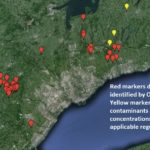Ontario now has soil regulations!
In the recent past, soil excavated for the foundations of homes and condo towers, for subways tunnels and highways, and for redeveloping contaminated industrial lands was disposed of in a haphazard and unregulated manner. It was dumped into old gravel pits, spread onto farmers’ fields, and slipped into wetlands. Upset at the truck traffic, dust, and noise and concerned about the impact of contaminated soil on their drinking water, neighbours of these soil dumps heard that municipalities didn’t have by-laws that covered the situation; that provincial and municipal authorities had no power over what went into runway construction; and the provincial ministry of the environment could only reference the “adverse effects” clause of the Environmental Protection Act.
Since that time, many affected municipalities have updated their by-laws to regulate the soil going into site alterations or commercial fill operations. The courts confirmed the right of the province (and municipalities) to regulate the soil going into aerodromes. Recently the provincial government brought in a new regulation titled On-Site and Excess Soil Management. The soil reuse rules of O. Reg. 406/19 came into effect January 1, 2021. On January 1, 2022 the requirements for testing of soil, tracking of trucks, and registration of soil movements will formally take effect.
These improvements in soil regulation in the federal, provincial, and municipal spheres will only bring about better management of excess soil if there is effective implementation, careful monitoring, and persuasive enforcement. Industry practises have to change. Not all municipalities have effective by-laws. Loopholes will be exploited. Therefore, in order to protect the environment and the health and property of Ontarians, the Ontario Soil Regulation Task Force (and this website) will continue to inform, educate and support improvements in the regulations governing the movement and deposition of excess soil.





